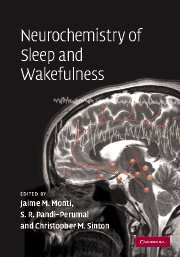Book contents
- Frontmatter
- Contents
- List of contributors
- Preface
- Acknowledgements
- Abbreviations
- I The neurochemistry of the states of sleep and wakefulness
- 1 Neurochemistry of the preoptic hypothalamic hypnogenic mechanism
- 2 Neuroanatomical and neurochemical basis of wakefulness and REM sleep systems
- 3 Rapid eye movement sleep regulation by modulation of the noradrenergic system
- II The influence of neurotransmitters on sleep and wakefulness
- III Changing perspectives
- Index
- Plate section
3 - Rapid eye movement sleep regulation by modulation of the noradrenergic system
from I - The neurochemistry of the states of sleep and wakefulness
Published online by Cambridge University Press: 23 October 2009
- Frontmatter
- Contents
- List of contributors
- Preface
- Acknowledgements
- Abbreviations
- I The neurochemistry of the states of sleep and wakefulness
- 1 Neurochemistry of the preoptic hypothalamic hypnogenic mechanism
- 2 Neuroanatomical and neurochemical basis of wakefulness and REM sleep systems
- 3 Rapid eye movement sleep regulation by modulation of the noradrenergic system
- II The influence of neurotransmitters on sleep and wakefulness
- III Changing perspectives
- Index
- Plate section
Summary
Abstract
Aserinsky & Kleitman (1953) identified within sleep a physiological state that expresses several signs apparently similar to those that occur during wakefulness. This state was termed rapid eye movement (REM) sleep. REM sleep may play a significant role in maintaining normal physiological functions, as its loss has serious detrimental psychopathological effects. The mechanism of REM sleep regulation is still unknown. The pontine cholinergic and noradrenergic transmissions in the brain undergo reciprocal variations in activity associated with the transformation from non-REM sleep to a REM sleep state and vice versa. The cessation of noradrenergic neuronal firing in the locus coeruleus (LC) plays a crucial role in the regulation of REM sleep. Disinhibition of the LC neurons may result in increased levels of noradrenaline (NA) in the brain, and this increased brain NA is likely to be responsible for the pathophysiological effects associated with REM sleep deprivation. Based on recent findings, we discuss the modulation as well as the role of LC neurons and NA in the modulation of REM sleep and the pathophysiological conditions associated with its deprivation. We propose that LC NA neurons are negative executive neurons for the regulation of REM sleep.
Introduction
One of the important characteristics of living beings is to alternate between active and rest phases, but the underlying mechanism/s and functions are not yet known.
- Type
- Chapter
- Information
- Neurochemistry of Sleep and Wakefulness , pp. 59 - 82Publisher: Cambridge University PressPrint publication year: 2008

